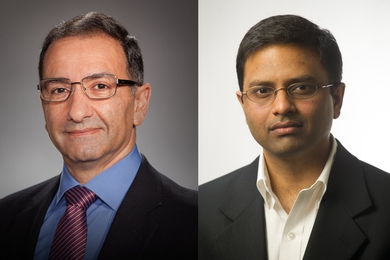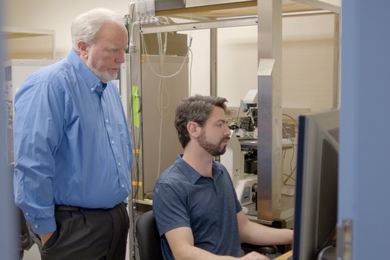Chief Judge Louis C. Bechtle of the US District Court in Philadelphia decided in favor of the government Wednesday (Sept. 2) in its antitrust case against MIT's policy on student aid scholarships.
The case "presented issues of surpassing importance to higher education in the United States," according to Eugene Gulland of Covington & Burling, the Washington attorney representing the 1500-college American Council on Education (ACE). The ACE was one of 16 organizations who filed friend of the court briefs on MIT's behalf, representing thousands of private, public and Catholic colleges. In addition to the colleges, friends of the court briefs were filed by the Philadelphia public schools and the Rockefeller Brothers Fund.
MIT said its need-based policy of distributing MIT scholarships is a policy of charitable gifts to students; the Antitrust Division of the Justice Department maintains that it involves price fixing.
The New York Times, the Washington Post, the Los Angeles Times, the Boston Globe, the Philadelphia Inquirer and the Chattanooga Times published editorials in favor of MIT in the case.
The New York Times, on May 3, in an editorial headlined "US vs. Needy Students," said, "The anti-trust laws are designed to stop price-fixing by commercial enterprises that exploit consumers. They are not intended to stop non-profit organizations from cooperating in charitable endeavors. Giving scholarship aid to needy students is surely a charitable activity." The headline on the Los Angeles Times editorial of May 24 said, "Can This Be Serious? Justice Department Picks Silly Fight with Top Schools."
The unprecedented antitrust case had its origins in an investigation begun in 1989 by the Justice Department. The Antitrust Division of the Justice Department reportedly sent civil investigative demands to some 57 colleges, who were asked to submit thousands of pounds of records over many years. In 1989, the last full year of participation in the agreement, 23 colleges attended the annual spring meeting to discuss the relative need of commonly admitted students.
The case was fought by MIT after the eight Ivy League colleges agreed in May, 1991 - while admitting no culpability - to sign a consent decree barring such cooperation for 10 years, unless Congress passes legislation to authorize it.
The civil suit involved an agreement that MIT and the eight Ivy League colleges entered into in the 1950s. The colleges agreed to admit students solely on the basis of merit and distribute their scholarship money solely on the basis of need.
They also agreed to establish methods of determining what the applicants' family could afford and - in the case of applicants who had overlapping offers of admission from more than one of the colleges - to discuss significant differences in the colleges' judgements of the individual students' financial need.
The overlap schools developed uniform principles for measuring need - essentially the same system adopted by the US Office of Education in the 1960s and later adapted by Congress, both of which require that most federal financial aid be awarded exclusively on the basis of need.
Financial aid administrators from the overlap group gathered each spring - the meetings were well-known and acknowledged by the federal government - to review and refine the uniform principles for assessing need, and also to determine the ability of the family of common applicants to pay for college. To accomplish the latter, the administrators took many factors into account, using their professional judgment. Usually - but not always - they reached a consensus on how much commonly admitted students and their parents could afford to pay.
The group believed that the overlap meetings served a public purpose by assuring students were admitted on merit and that available financial aid funds - both the colleges' private funds and government monies - were awarded on the basis of need only, thereby serving the largest possible group of eligible students. They enabled the participating colleges to preserve a need-blind admissions system and avoid the potentially costly results of a bidding system for relatively affluent students who did not need assistance in order to attend college.
The Federal government requires that a student who receives any Federal need-based aid cannot receive a total award from the government and the college that exceeds the students' need. Such aid is known as no-need aid or merit aid.
However, it was this lack of merit-based aid for the relatively affluent, as opposed to aid based solely on economic need, that prompted a Justice Department suit against MIT and the Ivy League colleges in May 1991. The Justice Department accused the group of violating the Sherman Antitrust Act "by illegally conspiring to restrain price competition on financial aid" to prospective undergraduate students.
The Justice Department said that individual colleges or universities could unilaterally establish a system of need-based aid, but that it was objecting to the "collusive establishment of a policy" to exclude merit as a consideration.
Shortly after the suit was filed, the Ivy League defendants - Brown, Columbia, Cornell, Dartmouth, Harvard, Pennsylvania, Princeton and Yale - signed a consent decree that settled the action against them. In it, they agreed that they would not collaborate on financial aid. The consent decree also prohibited any discussion or agreement on future tuition or faculty salary increases, although these were not cited in the complaint filed in May 1991.
Many of those signing the consent decree said they believed the overlap meetings were lawful, but that they wanted to avoid a costly legal battle.
MIT refused to sign. MIT President Charles M. Vest commented, "MIT has a long history of admitting students based on merit and a tradition of ensuring that students receive full financial aid based only on need. Our financial-aid process has been very effective for many years in helping talented students from low-income families attend MIT. We are confident in the integrity of our processes."
MIT's stand set the stage for the 10-day trial, starting June 25 and ending July 9, in US District Court in Philadelphia, where the government's suit had been filed by the then US Attorney General Richard Thornburgh.
In the landmark trial, the Justice Department's Antitrust Division asserted that the overlap agreement constituted price-fixing as defined by the Sherman Antitrust Law.
MIT, through its lead attorney, Thane D. Scott of Palmer and Dodge, countered that the Sherman act was never intended to apply to the kind of arrangements worked out by the overlap colleges for the assigning of essentially charitable funds.
Mr. Scott said that the government's claims were "myopic and misguided," based on "a one-size-fits-all approach under the antitrust laws to police commercial competition."
In his summation on July 9, Mr. Scott said, "MIT's function is to teach, to discover and to build. It is to leave to the next generation a better and more knowledgeable world.Yet in the eyes of the Antitrust Division, such an institution is indistinguishable from a manufacturer of toaster ovens or porcelain fixtures."
He quoted US Supreme Court Chief Justice William Rehnquist in his dissent in the 1984 NCAA-Oklahoma football case: "No decision of the United States Supreme Court suggests that associations of nonprofit educational institutions must defend their self-regulatory restraints solely in terms of their competitive impact, without regard for the legitimate non-economic values they promote."
In presenting its case, MIT made these key points:
- MIT financial aid is a gift policy, not a pricing policy.
- Tuition covers only half the cost of a student's education; all students receive a subsidy of more than $16,000 from MIT's endowment and income.
- Fifty-seven percent of students receive aid at MIT.
- The consent decree gave unequal treatment to non-athlete students by specifically excluding Ivy League athletes from the general ban on collaborative agreements.
The 13 witnesses called by MIT in the Philadelphia trial included four current and former college and university presidents, among them former MIT President Paul E. Gray. Answering the question, "Who is hurt if overlap doesn't continue?," Dr. Gray testified that if fewer financial-aid dollars were available to poorer students, this would "reduce the socio-economic diversity of the undergraduate level." He added, "I think in the end the Institute will suffer."
Another witness, Dr. Dennis W. Carlton, a University of Chicago economics professor who served as MIT's economic expert, said his study showed that MIT and the other overlap schools made no gain in revenue from the need-based system, as the government had asserted in its complaint.
Brown University filed a friend of the court brief on behalf of MIT, and was joined in that action by Cornell. After testimony ended, MIT's legal fight was joined by the Philadelphia public schools, associations for hundreds of colleges and the Rockefeller Brothers Fund, all of which filed friend-of-the court briefs in MIT's behalf.
Finally, in the wake of the trial, Congress passed, and President George Bush signed, a bill that permits colleges for the next two years to agree with one another to award financial aid only on the basis of "demonstrated financial need." It allows colleges to "discuss and voluntarily adopt defined principles of professional judgment" for determining financial aid but does not permit discussion and agreement in advance of scholarship awards in individual cases.
Besides the eight Ivies and MIT, the 23 colleges which formerly participated in the spring meetings included Amherst, Barnard, Bowdoin, Bryn Mawr, Colby, Middlebury, Mount Holyoke, Smith, Trinity, Tufts, Vassar, Wellesley and Williams.
The college-related organizations filing amicus briefs included the ACE; the United Negro College Fund; the 2,800-member College Board; the American Association of Universities; the Association of Catholic Colleges and Universities; the Association of Jesuit Colleges and Universities; the National Association of State Universities and Land Grant Colleges; the National Association of of Independent Colleges and Universities; the Council of Independent Colleges; the Association of American Medical Colleges; the National Association of Student Financial Aid Administrators; and the National Association of Student Personnel Administrators.





